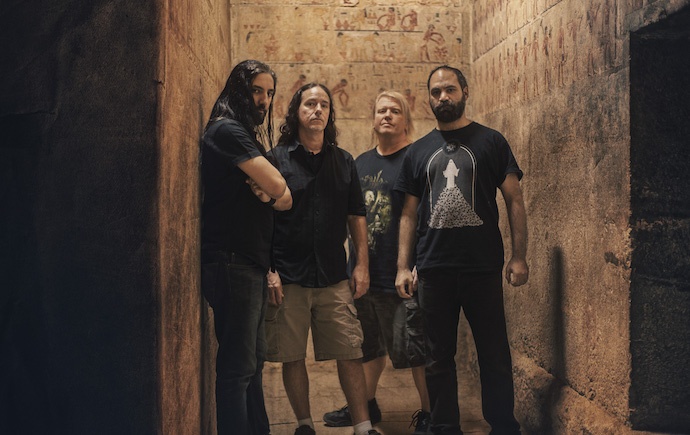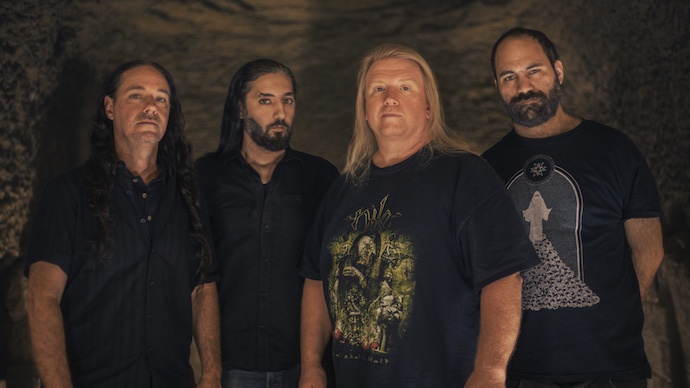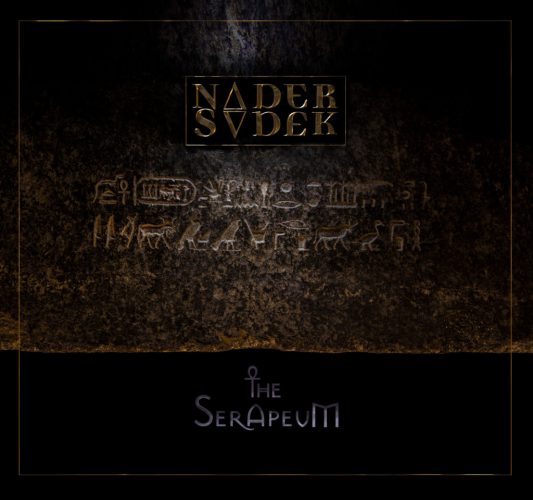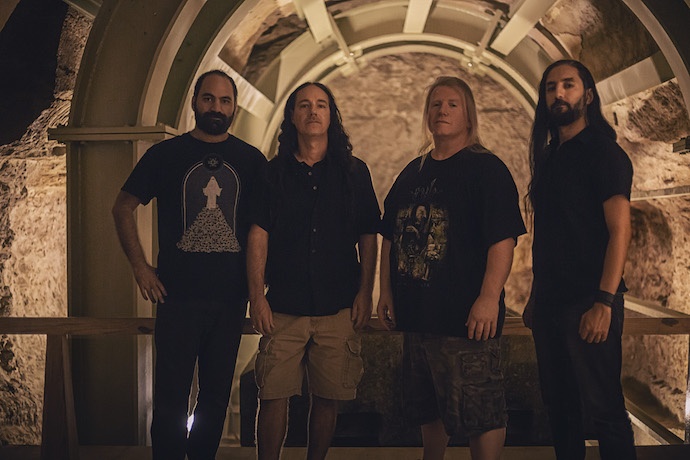
EDITOR’S NOTE: On November 20 the Egyptian metal artist Nader Sadek will release a remarkable EP named The Serapeum, which grew out of a collaboration in Egypt among Sadek, Karl Sanders (Nile), Derek Roddy (Serpents Rise), and Mahmud Gecekusu (Perversion).
The music on the EP also includes contributions by bassists Ben “Barby” Claus (Gorod) and Dominic “Forest” Lapointe (Augury) and vocalists Morean (Dark Fortress) and Shaun LaCanne (Putrid Pile), as well as Alex Zubair (Nephelium) creating eastern harmonies and drones, and Nancy Mounir adding theremin hauntings to the mix. Sadek himself recorded the vocals inside the inner chamber of Dahshur’s “Red Pyramid” (the pyramid of Snefru).
We will have the pleasure of premiering a full stream of the EP on November 19th. And today we’re presenting an interview about the EP that DJ Jet conducted with Nader Sadek, as well as a few questions she posed to Karl Sanders and Derek Roddy, and their answers. The circumstances in which the interview was conducted were unusual, and perhaps in time they will be revealed when and if it is safe to do so.
What is the music scene currently like in Egypt for metal bands and artists?
Not good, but there is progress. After some crazy people reported me to the corrupt musicians union, I was arrested for bringing Sepultura into Egypt to perform. This was devastating for everyone, including Egypt’s tourism. As Egypt was marked unsafe, this also completely destroyed the scene, which means these crazy people also shot themselves in the foot. However, as I said, there is progress and, well, I always wait for Karma to do her thing. As you know, she always has my back, so things will take an interesting turn and I have faith in that.
Nader how did this project come about this time around?
Cairometal.net, a small website promoting metal in Egypt, approached me with the idea of working with Karl Sanders of Nile. Karl and I had discussed working together way back in 2005-2006 but it never came to pass. He was busy and also it seemed somewhat obligatory because I didn’t feel that his addition conceptually would have been correct. In either case it would have been an honor, but we decided not to work together on that project, which ended up with Steve Tucker of Morbid Angel, Trym of Emperor, Alex Skolnick, and Ralph Santolla. It was called The Faithless.
Fast forward 2015. Cairometal had the idea that Karl would do vocals or a guitar solo. Of course I’d have been honored to have him do that, but I thought, lets Go BIG. I mean, I don’t know exactly how interesting that would have been for him. He does this all the time and I’m not sure how memorable it is. So I wanted to do something that he would never forget, something that would excite him and those around him, just make something truly Special!

Who did you round up as far as musicians go for this and why did you go about choosing who you did?
So the next thing was to figure out who else to bring. It was an absolute no-brainer to bring in my brother Derek Roddy. Not only do we enjoy working together, but I especially think we create some very special magic on stage. Derek also worked with Karl on the Nile album Black Seeds of Vengeance, and it’s such a great album too, so the most important thing was to present Chemistry. There’s nothing more important than Chemistry between a guitarist and a drummer. Once you’re confident about that, you can rest assured things will go well.
The next thing was to find someone from the region. I hate to admit it, but I really don’t think there are many musicians in the region with the kind of capability and understanding that’s needed. And that’s mostly because the governments in the region try to suppress metal. So I didn’t struggle — it was another no brainer that Mahmud was the man. He’s why his band Perversion annihilates anything that comes from the region. He’s based in Dubai, which is far away, but that’s the price you have to pay for quality musicianship and he’s also my good friend. But most of all he also understands my work very, very well. So when it came to post-production he and I could work together and he’d know what I’m looking for.
I knew that we had limited time. We had approximately 10 days, of which only 4-5 days would be available to write music, with the rest of the days doing touristy stuff. So I came up with the idea to make it more for us and for the fans, and to do two versions of the same song.
This became another thing to think about: Who are the players, with which instruments, and which version will they play on?
The first thing I wanted to do was to make opposite versions. The song made with Karl was warm, had a golden, eastern, and ancient feel to it. So it made sense to have the other version go in the opposite direction, which has this kind of cold, razor-sharp feel, which also suits the style heard on In the Flesh, an amalgamation of black and death metal, not by alternating riffs — a death metal with a black-metal riff — but somehow death metal played with the black metal spirit. This is the Nader Sadek way, which I had intended and felt succeeded in producing that record.
Of course Mahmud was the man for that, as he’s played with me before plus he understands my weird approach. I can talk to him and he can understand me. Not easy, and I had to do more of this with the bass, and again it had to be someone who understands black metal but is capable of playing technical death metal. I couldn’t find someone better than the amazing Ben “Barby” Claus, who is not just THE best French bass player (imo at least), but also a great friend and also very understanding of my vision and style. Then to go more black metal I wanted to include chants, and for that the incredible Morean – who once again is extremely knowledgeable in the death metal and black metal arts. Finally, I did want to keep things vocally rooted in death metal and got Putrid Piles‘ Shaun LaCanne. His guttural on the chorus just made it grossly Sick!
At some point or another, for reasons such as live concerts or pure friendly visitation, I had brought them to Egypt, which was also very important, that everyone who played on it had been on Egyptian soil.
For the warmer version, it was Dominic Lapointe and his amazing fretless bass wizardry, but this time I didn’t have to worry about the black metal aspect, because this was going to be eastern-sounding death metal. I definitely wanted to work with a local Egyptian and got Nancy Mounir, who plays the theremin. What a talented individual she is, and last and but not least is the awesome Alex Zubair, who added some beautiful eastern harmonies.

What is “The Serapeum” and what was the process like in writing and recording this EP single?
The Serapeum is an ancient burial cave with over a dozen sarcophagi, each weighing over 60-80 tons. It is an absolute mystery how they were cut, and moved in there. Even an American stone laser cutting company couldn’t explain how it was made, because its large slabs (seen in the beginning of the first video) seem to be cut into rectangles and scooped out like ice cream. It makes no sense — you’d have to cut the pieces and then find a way to attach them. It is said that this Serapeum housed mummified bulls, but they only found one bull and it’s from a different era than when the Serapeum was originally built, so everything is a mystery.
I had spoken to one of the biggest Egyptologists, Dr. Sameh Iskander, who had suggested it, and of course the name alone intrigued me. In Egypt I took my collaborators to the Serapeum and we explored the site. That was interesting — it’s a very strange place to walk into. Honestly, I thought it was a little scary. They built a wooden floor so the sand doesn’t kick up in the air. Another thing that was strange is there was no soot from smoke on the ceiling, which means they worked on it in the dark.
Anyway, the process involved going to ancient sites one day (other than the Serapeum) and then going home and resting, meeting up at night, having dinner, then going home to have restful sleep. The next day we would head into the studio and Derek, Karl and Mahmud would jam. I would watch them come up with ideas, riffs, and breakdowns here and there, Derek really took the bull (no pun intended) by the horns, and together they engineered this monster.
Personally, I can’t get creative in real time. I had to digest what they were doing and then come up with ideas after we got home. We had only enough time to jam 4-5 times, the 5th time being when we actually just played it over and over and made sure we got it more or less right. The last actual writing day would be the 4th. On the 3rd jamming day I came up with the chorus part. It was amazing watching them come up with the stuff, and they gave me the perfect opportunity to put my chorus in there. It was all quite magical. Later when everyone went home, I had the time to work on my vocals and lyrics.
Once I came up with lyrics and a vocal pattern that I was happy with, I decided to sing and record inside the pyramid of Snefru. It was also an ancient site that I had taken Derek and Karl and Mahmud to. The reason I wanted to record there is that the chambers of this pyramid specifically were built to manipulate sound frequency. Again this is mind-boggling, because no one understands the function of this. It’s very mysterious. No one understands the function, not even close, although there are many theories. Anyway, I wanted to do something where I could borrow something from the ancients and put it in the record, something that is meaningful and not just generic. So I thought of capturing this frequency that is created inside the chamber.
Please explain to us the 4 tracks of this record
It’s like a ’90s single. It’s 22 minutes of variations on the same song, as explained.
The original Nader Sadek blackened DM sound for “Black Osiris”.
Eastern-tinged drone experimentation shock plays off Karl’s guitar tone as we hear on his own music and Nile’s.
Then there’s an A Capella track I recorded inside the sarcophagus, called “ReSarcaphogus”.
Last but not least, a live version which was our very first live performance of the song.
So Karl, what were your thoughts when Nader first approached you with this project?
My response was a resounding Hell Yes. Working on a project together was something Nader and I had talked about for many years . Getting to play again with Derek I knew would also be a special rare opportunity to participate in some music that I knew would be Killer from the word go.

Was this your first time in Egypt? And if so what was the experience like for you?
It was a blast. Completely epic. Nader was a fabulous host during our stay, and took us to many incredible historic places. An unforgettable experience.
What was it like working with Nader in Egypt?
Well, Nader is pretty easy to work with . He never really tells anybody what to do, he just put some killer musicians in the same room and turned them loose. It was a lot of fun, Nader, Derek, and Mahmud are top-shelf.
We often hear there is a lot of controversy around the musical work he does in Egypt. Why do you think that is so?
Well, really who knows. Beyond the obvious issue that Metal is frowned upon in Egypt, and often lands even the nicest metal musicians in hot water. There seems to also be quite a bit of local scene turmoil in Cairo. In truth, Nader is a sweetheart of a guy, an incredible artist, a gentleman, and a metal brother. That kind of makes him exceptional right there. However, being a genuinely nice person making genuine and unique art does not necessarily go hand-in-hand with the realities of the music business; but that’s the world we live in. Hopefully Nader can resolve some of his current difficulties, and get back soon to doing what he truly loves — making incredible art and music.
Derek, what was this experience working with Nader in this project like for you?
Nader and I have been working together since 2016 and had always mentioned going to Egypt to work on music with fellow musicians. I had told him “I’m in” on any project that would get me to Egypt to see and experience the culture. And it was a great time indeed.
Having Karl and Mahmud there really made it feel comfortable, as we’ve all known each other for years. Decades in Karl’s case. And being Karl’s and my first time there made it a really special experience. Being able to visit some of the world’s best known “wonders” was a life-changing event in some cases. Going inside the red pyramid for example. Or seeing some elders of centuries old tribes perform songs that are literallyy 100s if not 1000s of years old. Walking some of the endless road markets and the food was great as well.
Nader is like me in regards to eating. He’s a pro at it and takes pride in finding great food. Lol.
Musically, it’s a very natural thing to work with these guys. Nader has a way of getting the right people together at the right time and this is a perfect example. Would do it again anytime.
Is this something you would like to perform live at some point or strictly a studio project?
We already played it live and would like to perform live again and incorporate it into our sets.
And Nader, what is planned next for this project?
A sick new one-hour album is in the works!!
Once you complete things with this project, what is up next for Nader Sadek?
Way more art, not just music, but integrating visual media such as video.

Very interesting interview and Nader Sadek has made great music for years. Looking forward to this EP. But what are the “controversies” surrounding him that are alluded to in the interview?
Eventually we can explain, but doing so now might be harmful to Nader.
Doesn’t seem terribly fair.
Awesome interesting interview.